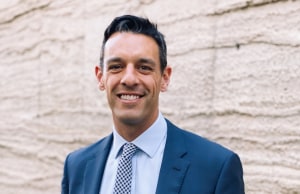The AUSPACK 2019 Business and Industry Conference, running parallel to the exhibition, is a valuable experience for packagers looking to find out more about trends affecting the industry. PKN's Jake Nelson has the highlights from day one.
Spice up packaging for digital, says McCormick sustainability guru
Dr Michael Okoroafor, vice-president for global sustainability and packaging innovation at McCormick, laid out what he saw as key insights driving the future of packaging for the FMCG industry in his keynote address.
The circular economy is one area of focus for McCormick, said Okoroafor, who told guests at the packed keynote session that it is creating a new age for packaging.
“The era of make-use-dispose is over. We’re in the era of make-use-reuse,” he said.
Packaging also needs to shift its focus if it is to be successful in e-commerce, he said, arguing that the current approach taken by packagers is wrong for online sales.
“There is no packaging designed for e-commerce – we take the packaging for brick-and-mortar, insulate it as if it’s a nuclear weapon in a corrugated box, and call it e-commerce.
“The time of first moment of truth is over. You have to design for zero moment of truth – if it doesn’t show well in the digital world it’s over. If it shows well, they can buy it right there or go to the store for it,” he said.
Three key takeaways:
- Packaging needs to move towards a circular economy. Recyclability or reusability is a must for the future.
- E-commerce is reshaping how packaging is designed – it has to look good not just on the shelf, but on the screen.
- Packaging can become the gateway to greater product transparency, with Industry 4.0 technologies allowing consumers to scan a package with their smartphones for more information.
“Perfect storm” to drive sustainable packaging
There are plenty of opportunities for packagers trying to meet the Australian Government’s 2025 National Packaging Waste Target, according to a panel of experts.
Craig Reucassel of The Chaser and War on Waste guided a discussion with Steve Lapidge, CEO of the Fight Food Waste Cooperative; Brooke Donnelly, CEO of the Australian Packaging Covenant Organisation (APCO); Paul Klymenko, CEO Planet Ark; and Caitlyn Richards, responsible sourcing manager for sustainable products and packaging at Coles, on how and why packagers should embrace sustainability.
According to Donnelly, consumer pressure on businesses, coupled with external pressure from the global supply chain, has created a “perfect storm” of conditions that have generated momentum for sustainable packaging.
“The conversation is live and active and has great momentum. The issue is corralling everyone with the best of intentions to have a structured and considered approach – you need to plan for how you’ll transition, to avoid perverse outcomes.
“Our conversation is no longer about should we do it – it’s about how we do it,” she said.
Richards noted that companies such as Coles need to look closely at their packaging to determine what’s necessary and what isn’t, and that solutions such as Planet Ark’s PREP tool and the Australian Recycling Label can help make this easier.
“We need to make sure all our packaging serves a purpose,” she said.
According to Klymenko, recycled material can be used for different purposes than it was originally – glass bottles, for example, can be used to make silicon chips, and other materials such as plastics can be mixed with asphalt for roads.
“It’s not always like for like,” he said.
Lapidge drew attention to best-before and use-by dates on packaging, saying they needed to be more conservatively applied.
“We need some regulation in this area – often it is just a marketing tool to get more stock rotation. It results in a lot of perfectly good food being thrown out,” he said.
Lastly, Reucassel himself noted that more investment is needed in waste management here in Australia, particularly in the wake of China’s foreign waste ban.
“I kind of expected the China crisis in recycling to lead to more investment in recycling in Australia, and I’m surprised how little there’s been,” he said.
Three key takeaways:
- The shift to sustainable packaging is no longer a matter of if, but when and how.
- Unnecessary packaging should be eliminated before companies think of what can be recycled or composted.
- Waste management in Australia needs more investment to ensure a transition to a circular economy.
Catch cuts carton costs
When e-commerce site Catch.com.au needed to optimise the size of its cartons for single item orders, it turned to ABBE Corrugated and the CMC Cartonwrap box-on-demand solution.
Consultant Dick Heintz, director of MarketKnowledge, took guests through how Catch transformed its business.
Prior to the consultation, Catch used carton reduction machinery to cut down existing boxes to size. While this worked for multiple-item orders, there was still a lot of wasted space in boxes containing only one item, which is not an uncommon problem in e-commerce, says Heintz: “Amazon still ships 50 per cent air in their boxes.”
The CMC Cartonwrap, supplied by ABBE Corrugated, uses sensors to determine the size and shape of individual items and creates boxes perfectly sized to fit them. This eliminates the need to ship empty air or void fillers, and has dispensed with the need for Catch to keep multiple sizes of carton in stock ready for shipping, according to Heintz.
“At one stage we counted 300 pallets of cardboard cartons. Now they have only 30-40 pallets – they make all their cartons from two sizes of fan folds,” he said.
This has slashed costs, particularly in volumetrics, with a 30 to 40 per cent reduction in volume shipped, leading as well to a lower carbon footprint.
“Within a year, the business case was proven,” said Heintz.
Three key takeaways:
- Box-on-demand solutions can cut shipping costs by eliminating wasted carton space.
- Operational costs can also be reduced due to lack of need for multiple carton sizes to be kept in stock.
- This also reduces carbon footprint and boosts sustainability.
The future is now for e-commerce
E-commerce offers a broad range of opportunities and challenges for the packaging sector, according to an expert panel.
MarketKnowledge director Dick Heintz facilitated an otherwise all-female panel comprising Amanda Green, e-commerce expert and former director for e-commerce at L’Oreal Australia; Helen Souness, CEO of RMIT Online; and Liza Nelson, regional account manager at Systech, who flew to Melbourne to attend the conference.
Sustainable e-commerce packaging was one area the panel touched on, with Souness encouraging companies to follow the expectations of millennials and Generation Z for greener pack; however, Green responded that companies should instead be leaders in this field.
“It comes back to the company itself to drive this and not wait for the younger generation to push it,” she said.
As an expert in brand protection, Nelson spoke about various ways it could be implemented for e-commerce; her own company, Systech, uses brand protection features embedded in the packaging itself for what she says is a cheaper and greener way to stop counterfeiting.
“We’re all used to today’s approaches to brand protection – they’re all additive and expensive,” she said, giving RFID chips as an example.
Souness and Green also discussed the integration of artificial intelligence into e-commerce, as well as the possibilities afforded by augmented reality.
“You can have incredibly targeted personalisation engines driven by AI,” said Souness, who talked about how AI-driven apps are reshaping the field of cosmetics, allowing customers to see what their faces will look like made up. “We’re seeing AI beating cancer surgeons for spotting problem cells. It’s not the future – it’s right now.
“The ability to experience a purchase before you actually make it really transforms retail,” she said.
Green added that online and brick-and-mortar retail is converging, with many online stores opening physical demo locations.
“No longer are customers going to a store and expecting to walk away with an item straight off. If you can get it to their house before they get home, so much the better,” she said.
Green also stressed that e-commerce operators need to focus on their supply chain and fulfilment before anything else.
“The first thing the customer gets from you is the package in the mail, so you need to focus on that first,” she said.
Three key takeaways:
- The worlds of online and physical shopping are converging.
- Companies need to set an example for sustainable e-commerce packaging.
- Artificial intelligence and augmented reality are revolutionary technologies for e-commerce.
Packaging needs to get smart, says expert
Active and intelligent packaging is a veritable Swiss army knife for packagers seeking to add value to their products, guests heard at the conference.
According to Andrew Manly, communications director at the Active and Intelligent Packaging Industry Association (AIPIA), it is important for packaging manufacturers to understand the use they can get from smart packaging.
“At AIPIA, we’ve been spending the past five or six years explaining the technology; now we have to tell people what it can do for them,” he said.
According to Manly, key drivers for active and intelligent packaging include consumer engagement; food security and safety; condition monitoring; reducing waste and extending supply chains; anti-counterfeiting and tampering; new legislation; compliance; smartphone use; new materials and technology; and cost reduction and scalability.
Manly touched on each of these drivers during the course of his presentation, highlighting a variety of examples and case studies as to how active and intelligent packaging is being used, including augmented and virtual reality marketing campaigns; smart water bottle caps that tell consumers when to drink for most effective hydration; and secure labelling for pharmaceuticals, for which Manly stressed the need to keep ahead of legislation.
“It’s better for the industry to lead the charge than to let the legislators lead the charge. Better to look at it ourselves and come up with solutions now than be told by the legislators later on,” he said.
Blockchain technology was one solution he proposed for product security and traceability, highlighting a flavoured water brand using it to give customers more information.
“Retailers are latching onto the fact that the customers want provenance. This technology can take you all the way back to the stream where the water was produced, if you want,” he said. “In five to ten years everyone in the retail sector will be using it to secure their supply chains. Walmart is already using it for fresh produce.”
Three key takeaways:
- Packagers need to understand how to use active and intelligent packaging to add value to their products for clients.
- Industry needs to stay ahead of legislation for product security and traceability.
- Blockchain is one new technology that can help with secure and transparent products.
Discovering an AR Treasury trove
Treasury Wine Estates has used augmented-reality technology to deliver new and exciting experiences to customers, thus boosting its own brands.
Ben Culligan, marketing director ANZ at Treasury Wine Estates, took guests through the winemaker’s AR marketing strategy. According to Culligan, with more than 24,000 wine brands worldwide and 10 in the average customer’s repertoire, consumers of “new world” wines especially are constantly after something new.
“Wine as a category is about discovering. People want to try something new and different – if you’re turning up to someone’s house you don’t want to bring the same bottle every time. That poses challenges for brand owners,” he said.
To solve this problem, Treasury “stopped thinking like a wine company and started thinking like a tech company”, using new technologies to attract customers, Culligan said.
Treasury’s 19 Crimes brand used AR experiences delivered through its Living Wine Labels app to make the wine labels “come to life” and tell the stories of the convicts featured on each one.
“You take your mobile phone, and you scan the label in-store or at home to unlock a brand experience compelling enough to share with friends,” he said.
The campaign was a smash hit, with a 400 per cent ROI on 19 Crimes, and Treasury expanded it across a range of other brands in its portfolio.
“This is only the start – we now need to work out what comes next, constantly thinking how consumer interactions with technology can help drive our brands,” said Culligan.
Three key takeaways:
- AR technology can deliver a unique brand experience to engage customers.
- Consumers will be eager to share these experiences with their friends, thus driving further purchases.
- In the future, AR solutions should be cloud-based rather than app-based, making them more universally accessible.
Let the sun shine in and save on power costs
A variety of new renewable power technologies could ease manufacturers’ reliance on the grid and reduce energy costs – if used right, says an expert.
Brett Wiskar, chief future officer at Wiley, said power prices are set to rise dramatically over the next twenty years, but many manufacturing businesses haven’t considered the potential in generating their own power.
“Energy generation is seen as non-core – they don’t do these things in businesses,” he said.
As an example of how renewable power sources can boost business, Wiskar pointed out agriculture company Sundrop Farms, which uses solar thermal technology to power a desalination plant, allowing Sundrop to grow tomatoes in the desert near Port Augusta.
“They’re using an energy solution to create an industry that didn’t exist before,” he said.
Key considerations for businesses seeking to generate their own power, including through photovoltaic solar cells which are becoming cheaper and cheaper, include the company’s consumption profile, location, grid provider, and rate at which they can sell excess power back to the grid.
Three key takeaways:
- Power generation needs to be consistent, or have some method of storage such as batteries to ensure energy is not wasted and can be used when generation can’t take place, for example with solar panels at night.
- Excess power can, depending on location, be sold back to the grid for additional revenue.
- Black and brown coal are not getting cheaper, but technologies such as solar thermal and photovoltaic cells are getting less expensive over time.












